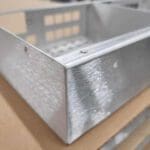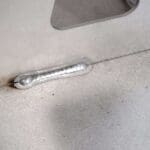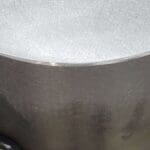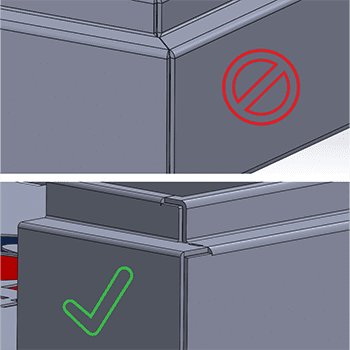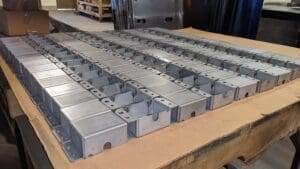Last updated on January 2nd, 2025 at 10:46 am
At Approved Sheet Metal, we take pride in our robust mastery of all things sheet metal fabrication—from materials sciences to the nuances of hardware selection to finishing options. As with sheet metal finishes, we’ve developed a proprietary system for classifying welding finishes to make selections easier for our customers.
Our team has 20+ years of experience welding prototypes to low-volume production quantities. We provide in-house welding capabilities, including MIG, TIG, and spot welding.
Table of Contents
- 1 Understanding the 3 Classes of Welding Finishes
- 2 Welding Finish Consideration: Material Selection
- 3 Sheet Metal Part Design for Manufacturing Tip
- 4 Sheet Metal Welding Finishes FAQ
- 4.0.1 What is the difference between Class A, Class B, and Class C welds?
- 4.0.2 Which welding finish is suitable for internal parts?
- 4.0.3 Can different materials have different welding finishes?
- 4.0.4 How do I determine the best welding finish for my part?
- 4.0.5 Can I upgrade a Class C welding finish to a higher class for stainless steel parts?
Understanding the 3 Classes of Welding Finishes
Our best-in-class welders can achieve any of the three classes of welding finishes to meet our customers' needs:
1. Class A Welds
The most expensive option, a Class A weld provides the best, most refined finish possible. Class A welds showcase a beautiful grain and are exceptionally smooth; these welds can look like some plastics, appearing completely seamless.
Class A welds are often reserved for cosmetic finishes and higher-priced projects as they require more time and effort to achieve. First, one of our welders lays down the beading. Then we give the weld a few quick passes with a Scotch-Brite wheel to maximize smoothness and minimize decolorization. Finally, we use a stroke sander or polisher and regrain the metal.
2. Class B Welds
A step down from Class A, Class B welds are less refined but not completely untreated. The surface isn't as smooth as a Class A weld but is flatter than a Class C weld.
Class B welds are often requested for internal parts or parts that will undergo further finishing treatments. Powder coating, for instance, will cover most imperfections associated with Class B welds.
To achieve a Class B weld, one of our welders lays down the beading and then uses the same Scotch-Brite wheel treatment as they would for a Class A weld. A couple of quick passes of the Scotch-Brite wheel reduce decolorization, and the Class B weld is complete. There is no final grinding or polishing step—the Class B weld is slightly raised but mostly smooth.
3. Class C Welds
The sheet metal fabrication shop standard, especially for internal parts, Class C welds are "raw" or untreated.
These welds aren’t ground down, polished, or smoothed. Instead, they are left raised in their original welding state with a visible edge.
All custom sheet metal welding projects begin as Class C welds. Class C welds can then become Class B welds and ultimately level up to Class A welds.
Welding Finish Consideration: Material Selection
The most common materials we weld are aluminum, stainless steel, and steel. When you look closely at examples of these materials with Class A, B, and C welds, you can see how the welds appear different on each material.
Aluminum
Aluminum is a strong candidate for each of the three classes of welding finish.
Many customers opt for aluminum when welding is involved because it can be polished and grained as a Class A weld, smoothed out a bit as a Class B weld, or left raised in its original Class C weld state.
Aluminum can be anodized and finished to look smooth, but welding finishes on stainless steel typically look even nicer.
Stainless steel
Any welding finish is achievable with stainless steel, but the Class A weld is particularly impressive. It's an excellent choice for external parts or any parts that require cosmetic finishes.
Looking at the Class C welding finishes for stainless steel versus aluminum, you can see how the natural weld is much darker on the stainless steel due to the material’s properties.
When selecting a welding finish, it's essential to keep coloration in mind. Upgrading a Class C finish to a Class B finish on a stainless steel part can significantly reduce discoloration, should that be necessary.
Steel
We'll cut to the chase—we do not offer a Class A weld finish for steel, as most parts will be powder coated or finished with orbital sanding. Steel is minimally corrosion-resistant, so steel parts typically receive finishing treatments that protect the metal and cover the weld, rendering a Class A welding finish unnecessary.
A Class B weld is the most common for steel parts and is better than a natural weld state for parts that will undergo finishing treatments.
How to Know Which Welding Finish Is Best for Your Part
Still not sure which welding finish is best for your custom sheet metal fabrication? Ask yourself these three questions:
- Is the part internal only? A Class C weld might be acceptable.
- Are you working with a tight budget or timeline? A Class B or even Class C weld is likely sufficient, provided you don’t need a refined, superior finish.
- Will there be other finishing treatments such as anodizing, powder-coating, or orbital sanding? Depending on your finishing treatments, you may not need to spend the time and money on a Class A weld.
Standards and Specifications
Incorporating industry standards and specifications into your welding processes is essential for ensuring quality, safety, and consistency. Adherence to these standards not only meets regulatory requirements but also enhances customer confidence in your products.
American Welding Society (AWS) Standards
The AWS has developed over 350 standards covering various aspects of welding practices and procedures. A key standard is the AWS D1.1 Structural Welding Code – Steel, which outlines requirements for welding steel structures. These standards provide engineers and fabricators with guidelines to ensure safety and quality in welding operations.
ISO Standards
The International Organization for Standardization (ISO) offers several standards pertinent to welding:
- ISO 15614-4: Specifies how a welding procedure specification for finishing welding of aluminum castings is qualified by welding procedure tests.
- ISO 15610:2023: Details how a welding procedure can be qualified using tested welding consumable data, expanding on the requirements given in ISO 15607.
- ISO 3834: Defines quality requirements for fusion welding of metallic materials, providing guidelines to ensure high-quality welds.
Welding Symbols and Notations
Proper communication of welding requirements is facilitated through standardized symbols. The AWS A2.4 Standard Symbols for Welding, Brazing, and Nondestructive Examination provides a complete presentation of standard welding symbols, ensuring clear and consistent communication across engineering and fabrication teams.
Implementing Standards in Your Processes
Aligning your welding finishes with recognized standards can enhance product quality and customer satisfaction. While proprietary classifications, such as Approved Sheet Metal's three classes of welding finishes, offer tailored solutions, referencing industry standards provides a benchmark for quality and facilitates clear communication with clients familiar with these specifications.
By integrating these standards into your welding processes, you ensure that your products meet international quality and safety benchmarks, fostering trust and reliability with your customers.
When in doubt, the Approved Sheet Metal team is here to help you. We're happy to discuss your project and recommend a welding finish that suits your specifications and budget.
Are you ready to get started on your next custom sheet metal welding project? Let's work together! Request a quote today.

